Southern Cross University: Management Communication Report Analysis
VerifiedAdded on 2023/06/04
|11
|2384
|150
Report
AI Summary
This report, prepared for a Management Communication course, investigates the critical need for effective communication in management. It explores the personal and interpersonal facets of communication, emphasizing persuasive techniques and the influence of personal networks and the grapevine. The report delves into formal communication channels within organizations, including downward, upward, and horizontal flows, while also examining informal channels and their impact. Furthermore, it addresses communication strategies related to sustainability, such as the communication of corporate social responsibility initiatives. The report examines communication theories across various organizational levels and provides recommendations for the implementation of effective communication processes, including strategies for crisis management and adaptation to organizational changes. The report underscores the importance of audience identification, the translation of communication objectives into actionable missions, and the role of effective communication in fostering employee benefits and resolving conflicts.
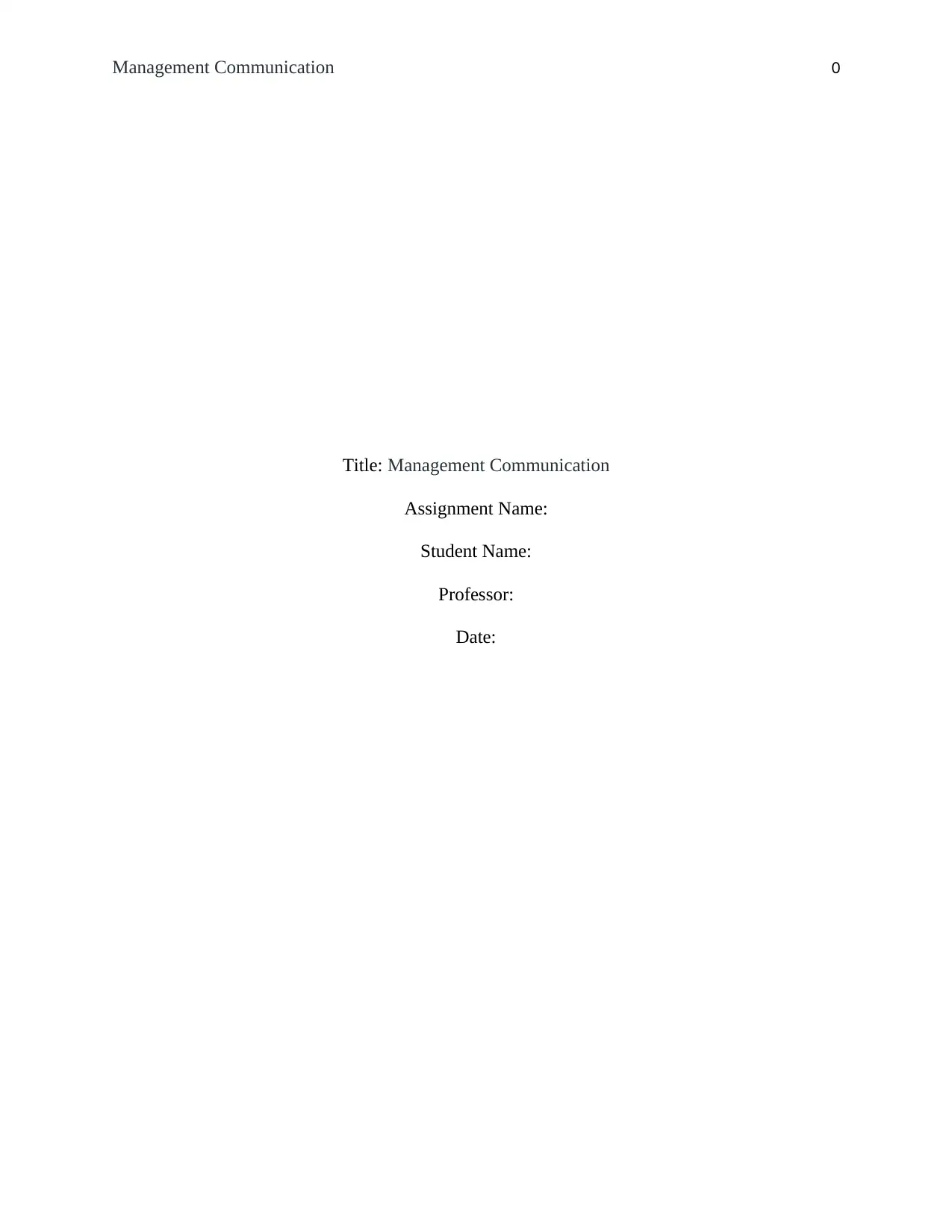
Management Communication 0
Title: Management Communication
Assignment Name:
Student Name:
Professor:
Date:
Title: Management Communication
Assignment Name:
Student Name:
Professor:
Date:
Paraphrase This Document
Need a fresh take? Get an instant paraphrase of this document with our AI Paraphraser
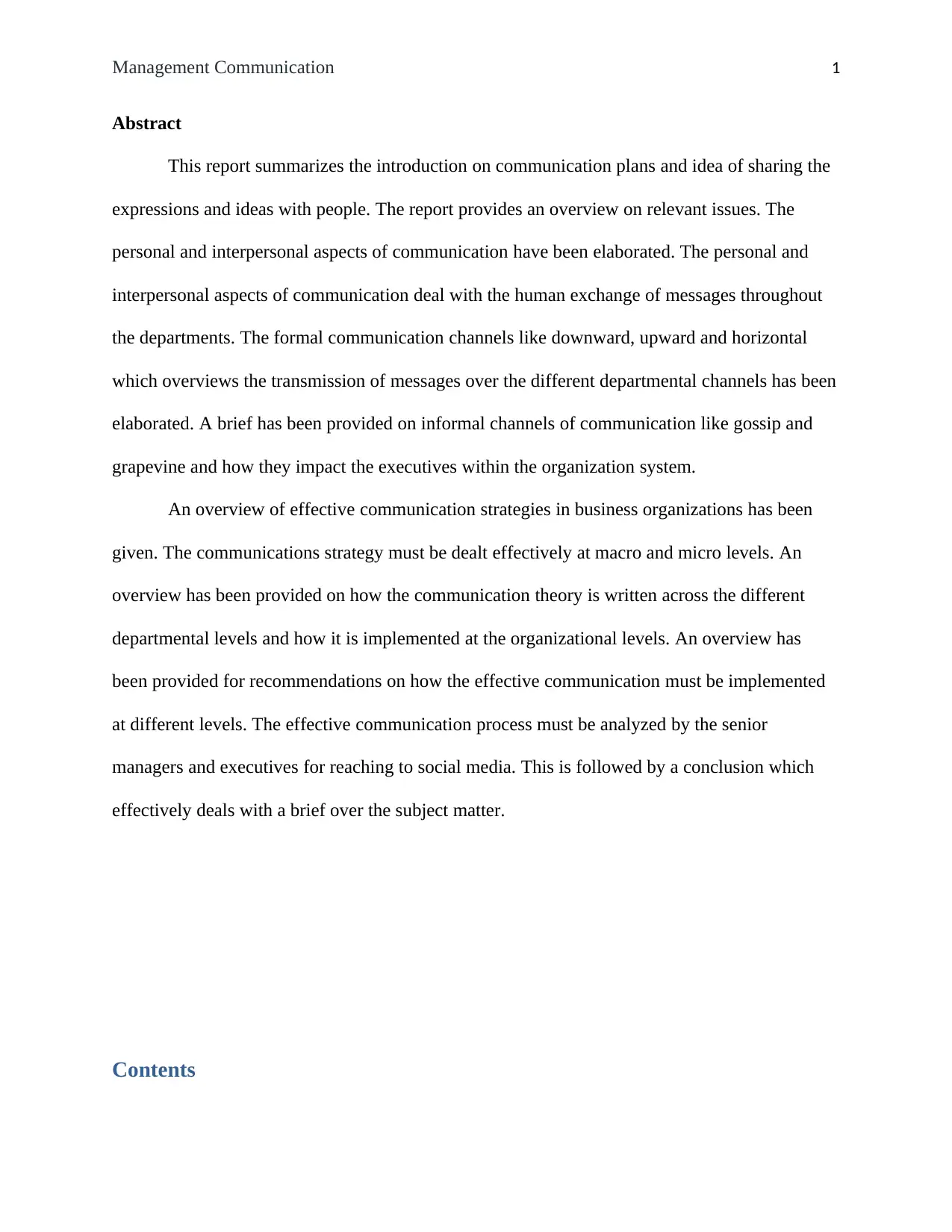
Management Communication 1
Abstract
This report summarizes the introduction on communication plans and idea of sharing the
expressions and ideas with people. The report provides an overview on relevant issues. The
personal and interpersonal aspects of communication have been elaborated. The personal and
interpersonal aspects of communication deal with the human exchange of messages throughout
the departments. The formal communication channels like downward, upward and horizontal
which overviews the transmission of messages over the different departmental channels has been
elaborated. A brief has been provided on informal channels of communication like gossip and
grapevine and how they impact the executives within the organization system.
An overview of effective communication strategies in business organizations has been
given. The communications strategy must be dealt effectively at macro and micro levels. An
overview has been provided on how the communication theory is written across the different
departmental levels and how it is implemented at the organizational levels. An overview has
been provided for recommendations on how the effective communication must be implemented
at different levels. The effective communication process must be analyzed by the senior
managers and executives for reaching to social media. This is followed by a conclusion which
effectively deals with a brief over the subject matter.
Contents
Abstract
This report summarizes the introduction on communication plans and idea of sharing the
expressions and ideas with people. The report provides an overview on relevant issues. The
personal and interpersonal aspects of communication have been elaborated. The personal and
interpersonal aspects of communication deal with the human exchange of messages throughout
the departments. The formal communication channels like downward, upward and horizontal
which overviews the transmission of messages over the different departmental channels has been
elaborated. A brief has been provided on informal channels of communication like gossip and
grapevine and how they impact the executives within the organization system.
An overview of effective communication strategies in business organizations has been
given. The communications strategy must be dealt effectively at macro and micro levels. An
overview has been provided on how the communication theory is written across the different
departmental levels and how it is implemented at the organizational levels. An overview has
been provided for recommendations on how the effective communication must be implemented
at different levels. The effective communication process must be analyzed by the senior
managers and executives for reaching to social media. This is followed by a conclusion which
effectively deals with a brief over the subject matter.
Contents
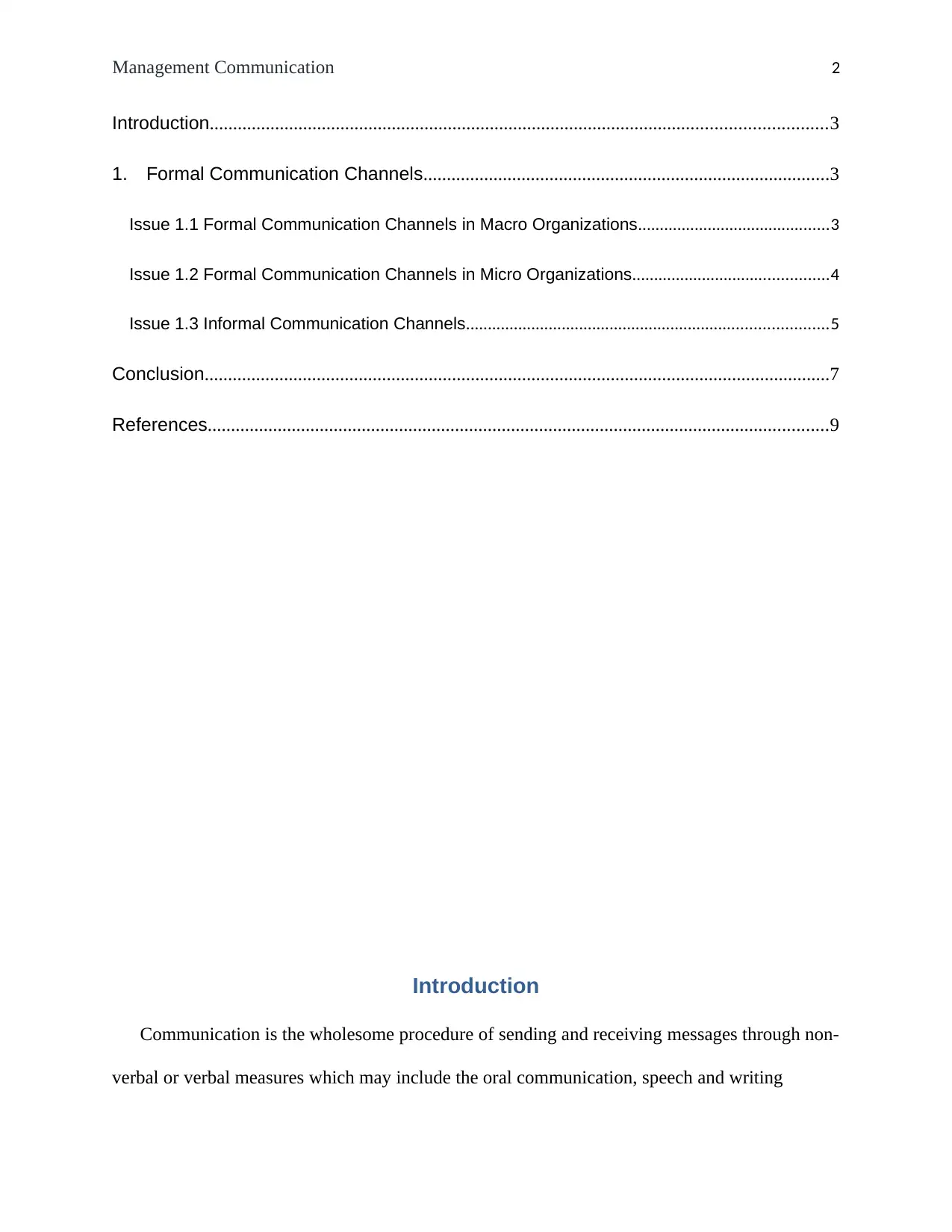
Management Communication 2
Introduction....................................................................................................................................3
1. Formal Communication Channels.......................................................................................3
Issue 1.1 Formal Communication Channels in Macro Organizations............................................3
Issue 1.2 Formal Communication Channels in Micro Organizations.............................................4
Issue 1.3 Informal Communication Channels...................................................................................5
Conclusion......................................................................................................................................7
References.....................................................................................................................................9
Introduction
Communication is the wholesome procedure of sending and receiving messages through non-
verbal or verbal measures which may include the oral communication, speech and writing
Introduction....................................................................................................................................3
1. Formal Communication Channels.......................................................................................3
Issue 1.1 Formal Communication Channels in Macro Organizations............................................3
Issue 1.2 Formal Communication Channels in Micro Organizations.............................................4
Issue 1.3 Informal Communication Channels...................................................................................5
Conclusion......................................................................................................................................7
References.....................................................................................................................................9
Introduction
Communication is the wholesome procedure of sending and receiving messages through non-
verbal or verbal measures which may include the oral communication, speech and writing
⊘ This is a preview!⊘
Do you want full access?
Subscribe today to unlock all pages.

Trusted by 1+ million students worldwide
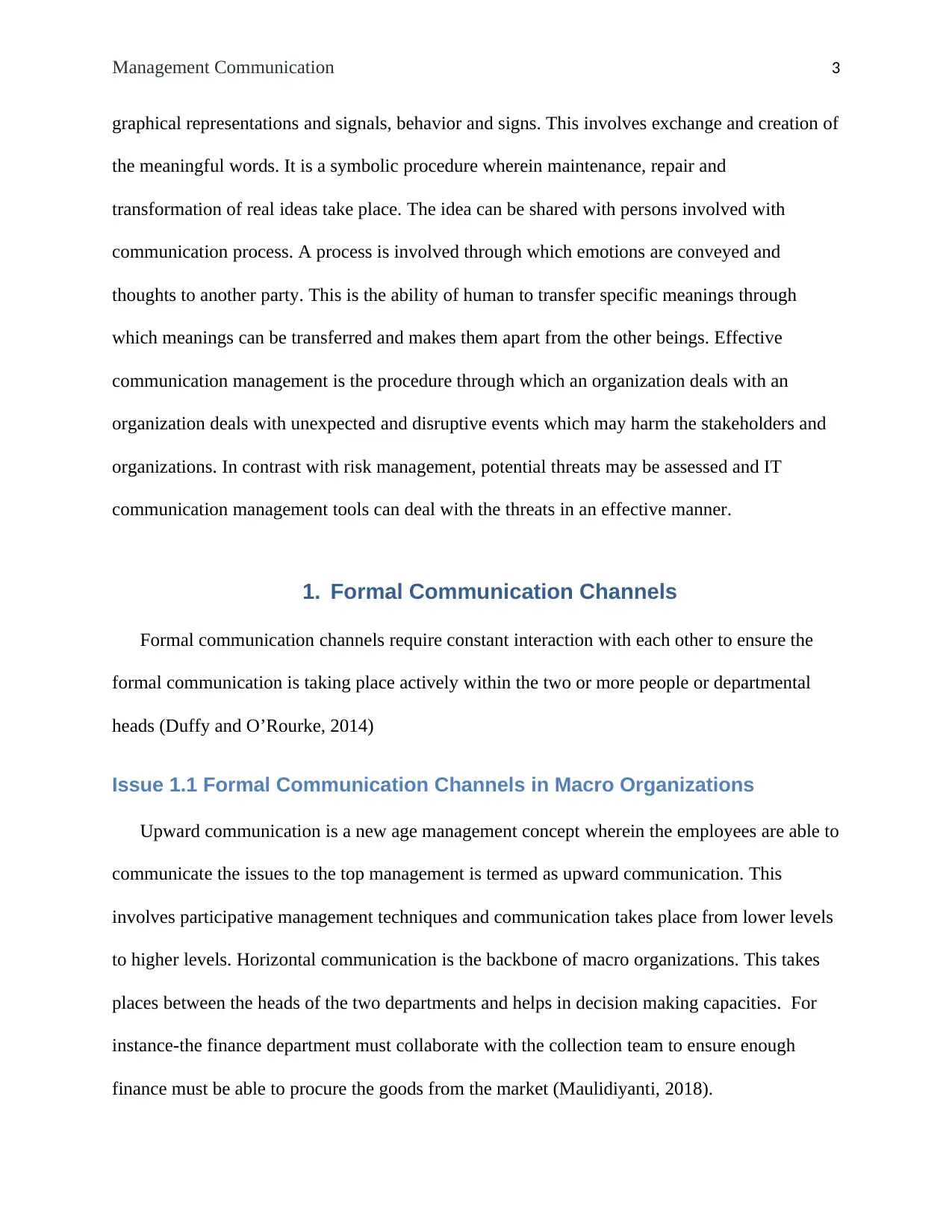
Management Communication 3
graphical representations and signals, behavior and signs. This involves exchange and creation of
the meaningful words. It is a symbolic procedure wherein maintenance, repair and
transformation of real ideas take place. The idea can be shared with persons involved with
communication process. A process is involved through which emotions are conveyed and
thoughts to another party. This is the ability of human to transfer specific meanings through
which meanings can be transferred and makes them apart from the other beings. Effective
communication management is the procedure through which an organization deals with an
organization deals with unexpected and disruptive events which may harm the stakeholders and
organizations. In contrast with risk management, potential threats may be assessed and IT
communication management tools can deal with the threats in an effective manner.
1. Formal Communication Channels
Formal communication channels require constant interaction with each other to ensure the
formal communication is taking place actively within the two or more people or departmental
heads (Duffy and O’Rourke, 2014)
Issue 1.1 Formal Communication Channels in Macro Organizations
Upward communication is a new age management concept wherein the employees are able to
communicate the issues to the top management is termed as upward communication. This
involves participative management techniques and communication takes place from lower levels
to higher levels. Horizontal communication is the backbone of macro organizations. This takes
places between the heads of the two departments and helps in decision making capacities. For
instance-the finance department must collaborate with the collection team to ensure enough
finance must be able to procure the goods from the market (Maulidiyanti, 2018).
graphical representations and signals, behavior and signs. This involves exchange and creation of
the meaningful words. It is a symbolic procedure wherein maintenance, repair and
transformation of real ideas take place. The idea can be shared with persons involved with
communication process. A process is involved through which emotions are conveyed and
thoughts to another party. This is the ability of human to transfer specific meanings through
which meanings can be transferred and makes them apart from the other beings. Effective
communication management is the procedure through which an organization deals with an
organization deals with unexpected and disruptive events which may harm the stakeholders and
organizations. In contrast with risk management, potential threats may be assessed and IT
communication management tools can deal with the threats in an effective manner.
1. Formal Communication Channels
Formal communication channels require constant interaction with each other to ensure the
formal communication is taking place actively within the two or more people or departmental
heads (Duffy and O’Rourke, 2014)
Issue 1.1 Formal Communication Channels in Macro Organizations
Upward communication is a new age management concept wherein the employees are able to
communicate the issues to the top management is termed as upward communication. This
involves participative management techniques and communication takes place from lower levels
to higher levels. Horizontal communication is the backbone of macro organizations. This takes
places between the heads of the two departments and helps in decision making capacities. For
instance-the finance department must collaborate with the collection team to ensure enough
finance must be able to procure the goods from the market (Maulidiyanti, 2018).
Paraphrase This Document
Need a fresh take? Get an instant paraphrase of this document with our AI Paraphraser
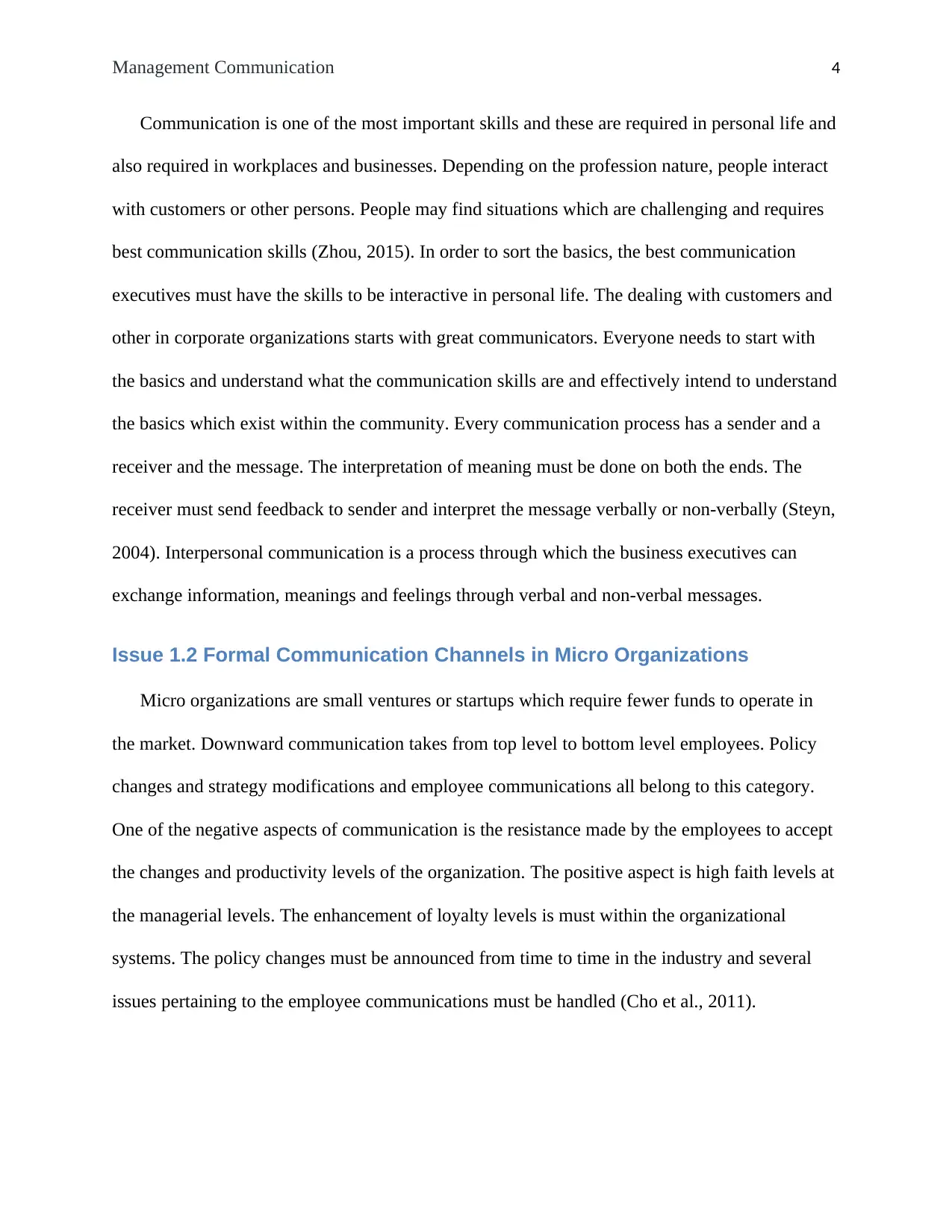
Management Communication 4
Communication is one of the most important skills and these are required in personal life and
also required in workplaces and businesses. Depending on the profession nature, people interact
with customers or other persons. People may find situations which are challenging and requires
best communication skills (Zhou, 2015). In order to sort the basics, the best communication
executives must have the skills to be interactive in personal life. The dealing with customers and
other in corporate organizations starts with great communicators. Everyone needs to start with
the basics and understand what the communication skills are and effectively intend to understand
the basics which exist within the community. Every communication process has a sender and a
receiver and the message. The interpretation of meaning must be done on both the ends. The
receiver must send feedback to sender and interpret the message verbally or non-verbally (Steyn,
2004). Interpersonal communication is a process through which the business executives can
exchange information, meanings and feelings through verbal and non-verbal messages.
Issue 1.2 Formal Communication Channels in Micro Organizations
Micro organizations are small ventures or startups which require fewer funds to operate in
the market. Downward communication takes from top level to bottom level employees. Policy
changes and strategy modifications and employee communications all belong to this category.
One of the negative aspects of communication is the resistance made by the employees to accept
the changes and productivity levels of the organization. The positive aspect is high faith levels at
the managerial levels. The enhancement of loyalty levels is must within the organizational
systems. The policy changes must be announced from time to time in the industry and several
issues pertaining to the employee communications must be handled (Cho et al., 2011).
Communication is one of the most important skills and these are required in personal life and
also required in workplaces and businesses. Depending on the profession nature, people interact
with customers or other persons. People may find situations which are challenging and requires
best communication skills (Zhou, 2015). In order to sort the basics, the best communication
executives must have the skills to be interactive in personal life. The dealing with customers and
other in corporate organizations starts with great communicators. Everyone needs to start with
the basics and understand what the communication skills are and effectively intend to understand
the basics which exist within the community. Every communication process has a sender and a
receiver and the message. The interpretation of meaning must be done on both the ends. The
receiver must send feedback to sender and interpret the message verbally or non-verbally (Steyn,
2004). Interpersonal communication is a process through which the business executives can
exchange information, meanings and feelings through verbal and non-verbal messages.
Issue 1.2 Formal Communication Channels in Micro Organizations
Micro organizations are small ventures or startups which require fewer funds to operate in
the market. Downward communication takes from top level to bottom level employees. Policy
changes and strategy modifications and employee communications all belong to this category.
One of the negative aspects of communication is the resistance made by the employees to accept
the changes and productivity levels of the organization. The positive aspect is high faith levels at
the managerial levels. The enhancement of loyalty levels is must within the organizational
systems. The policy changes must be announced from time to time in the industry and several
issues pertaining to the employee communications must be handled (Cho et al., 2011).
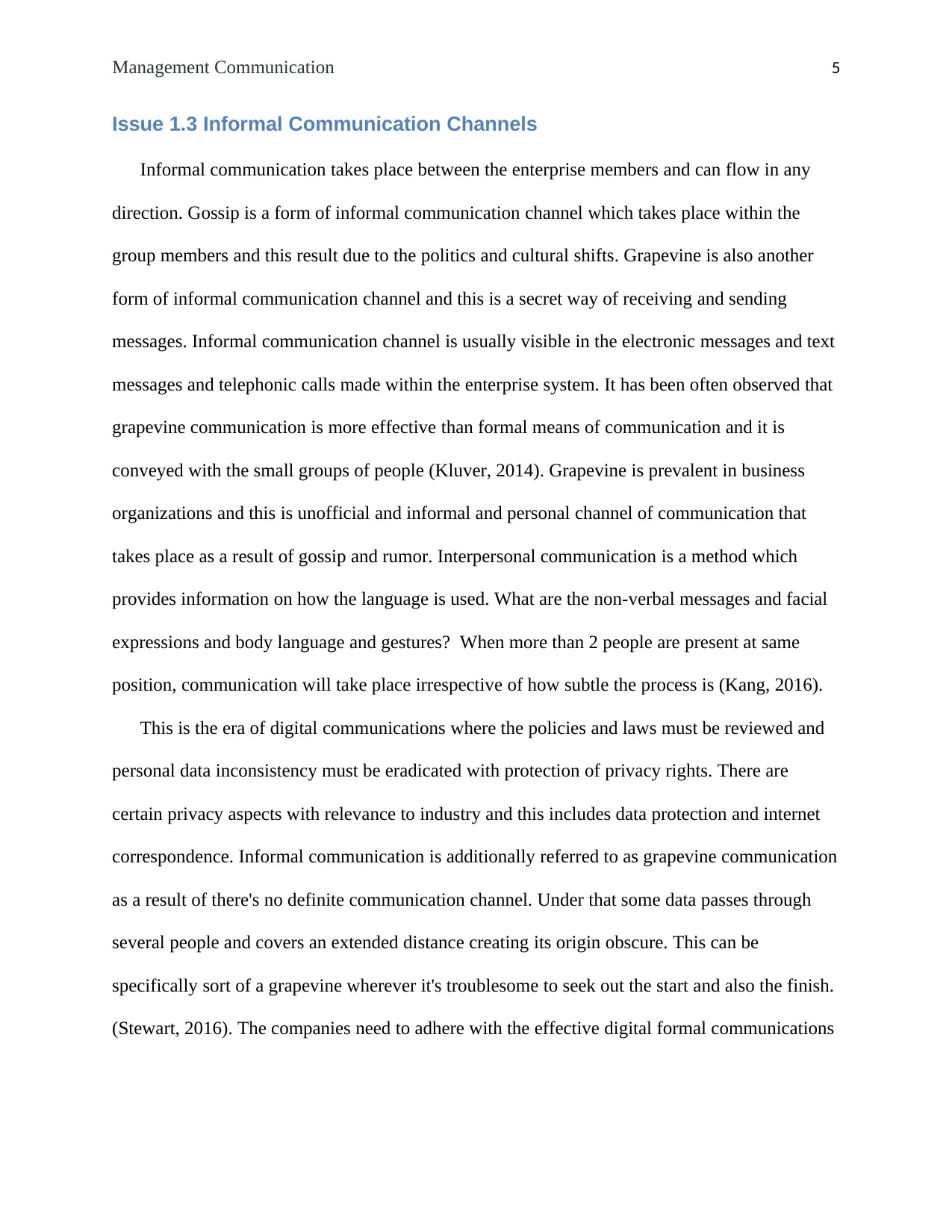
Management Communication 5
Issue 1.3 Informal Communication Channels
Informal communication takes place between the enterprise members and can flow in any
direction. Gossip is a form of informal communication channel which takes place within the
group members and this result due to the politics and cultural shifts. Grapevine is also another
form of informal communication channel and this is a secret way of receiving and sending
messages. Informal communication channel is usually visible in the electronic messages and text
messages and telephonic calls made within the enterprise system. It has been often observed that
grapevine communication is more effective than formal means of communication and it is
conveyed with the small groups of people (Kluver, 2014). Grapevine is prevalent in business
organizations and this is unofficial and informal and personal channel of communication that
takes place as a result of gossip and rumor. Interpersonal communication is a method which
provides information on how the language is used. What are the non-verbal messages and facial
expressions and body language and gestures? When more than 2 people are present at same
position, communication will take place irrespective of how subtle the process is (Kang, 2016).
This is the era of digital communications where the policies and laws must be reviewed and
personal data inconsistency must be eradicated with protection of privacy rights. There are
certain privacy aspects with relevance to industry and this includes data protection and internet
correspondence. Informal communication is additionally referred to as grapevine communication
as a result of there's no definite communication channel. Under that some data passes through
several people and covers an extended distance creating its origin obscure. This can be
specifically sort of a grapevine wherever it's troublesome to seek out the start and also the finish.
(Stewart, 2016). The companies need to adhere with the effective digital formal communications
Issue 1.3 Informal Communication Channels
Informal communication takes place between the enterprise members and can flow in any
direction. Gossip is a form of informal communication channel which takes place within the
group members and this result due to the politics and cultural shifts. Grapevine is also another
form of informal communication channel and this is a secret way of receiving and sending
messages. Informal communication channel is usually visible in the electronic messages and text
messages and telephonic calls made within the enterprise system. It has been often observed that
grapevine communication is more effective than formal means of communication and it is
conveyed with the small groups of people (Kluver, 2014). Grapevine is prevalent in business
organizations and this is unofficial and informal and personal channel of communication that
takes place as a result of gossip and rumor. Interpersonal communication is a method which
provides information on how the language is used. What are the non-verbal messages and facial
expressions and body language and gestures? When more than 2 people are present at same
position, communication will take place irrespective of how subtle the process is (Kang, 2016).
This is the era of digital communications where the policies and laws must be reviewed and
personal data inconsistency must be eradicated with protection of privacy rights. There are
certain privacy aspects with relevance to industry and this includes data protection and internet
correspondence. Informal communication is additionally referred to as grapevine communication
as a result of there's no definite communication channel. Under that some data passes through
several people and covers an extended distance creating its origin obscure. This can be
specifically sort of a grapevine wherever it's troublesome to seek out the start and also the finish.
(Stewart, 2016). The companies need to adhere with the effective digital formal communications
⊘ This is a preview!⊘
Do you want full access?
Subscribe today to unlock all pages.

Trusted by 1+ million students worldwide
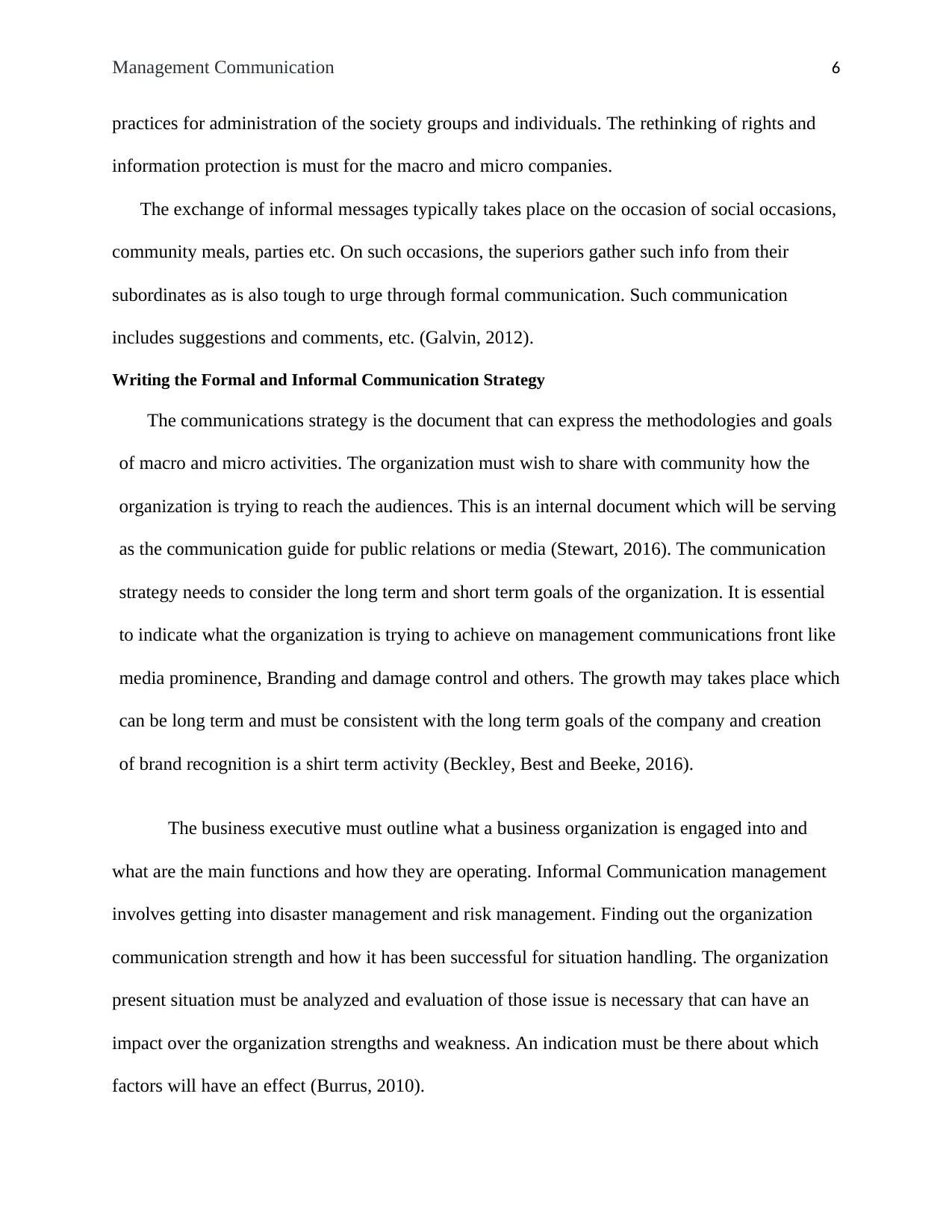
Management Communication 6
practices for administration of the society groups and individuals. The rethinking of rights and
information protection is must for the macro and micro companies.
The exchange of informal messages typically takes place on the occasion of social occasions,
community meals, parties etc. On such occasions, the superiors gather such info from their
subordinates as is also tough to urge through formal communication. Such communication
includes suggestions and comments, etc. (Galvin, 2012).
Writing the Formal and Informal Communication Strategy
The communications strategy is the document that can express the methodologies and goals
of macro and micro activities. The organization must wish to share with community how the
organization is trying to reach the audiences. This is an internal document which will be serving
as the communication guide for public relations or media (Stewart, 2016). The communication
strategy needs to consider the long term and short term goals of the organization. It is essential
to indicate what the organization is trying to achieve on management communications front like
media prominence, Branding and damage control and others. The growth may takes place which
can be long term and must be consistent with the long term goals of the company and creation
of brand recognition is a shirt term activity (Beckley, Best and Beeke, 2016).
The business executive must outline what a business organization is engaged into and
what are the main functions and how they are operating. Informal Communication management
involves getting into disaster management and risk management. Finding out the organization
communication strength and how it has been successful for situation handling. The organization
present situation must be analyzed and evaluation of those issue is necessary that can have an
impact over the organization strengths and weakness. An indication must be there about which
factors will have an effect (Burrus, 2010).
practices for administration of the society groups and individuals. The rethinking of rights and
information protection is must for the macro and micro companies.
The exchange of informal messages typically takes place on the occasion of social occasions,
community meals, parties etc. On such occasions, the superiors gather such info from their
subordinates as is also tough to urge through formal communication. Such communication
includes suggestions and comments, etc. (Galvin, 2012).
Writing the Formal and Informal Communication Strategy
The communications strategy is the document that can express the methodologies and goals
of macro and micro activities. The organization must wish to share with community how the
organization is trying to reach the audiences. This is an internal document which will be serving
as the communication guide for public relations or media (Stewart, 2016). The communication
strategy needs to consider the long term and short term goals of the organization. It is essential
to indicate what the organization is trying to achieve on management communications front like
media prominence, Branding and damage control and others. The growth may takes place which
can be long term and must be consistent with the long term goals of the company and creation
of brand recognition is a shirt term activity (Beckley, Best and Beeke, 2016).
The business executive must outline what a business organization is engaged into and
what are the main functions and how they are operating. Informal Communication management
involves getting into disaster management and risk management. Finding out the organization
communication strength and how it has been successful for situation handling. The organization
present situation must be analyzed and evaluation of those issue is necessary that can have an
impact over the organization strengths and weakness. An indication must be there about which
factors will have an effect (Burrus, 2010).
Paraphrase This Document
Need a fresh take? Get an instant paraphrase of this document with our AI Paraphraser
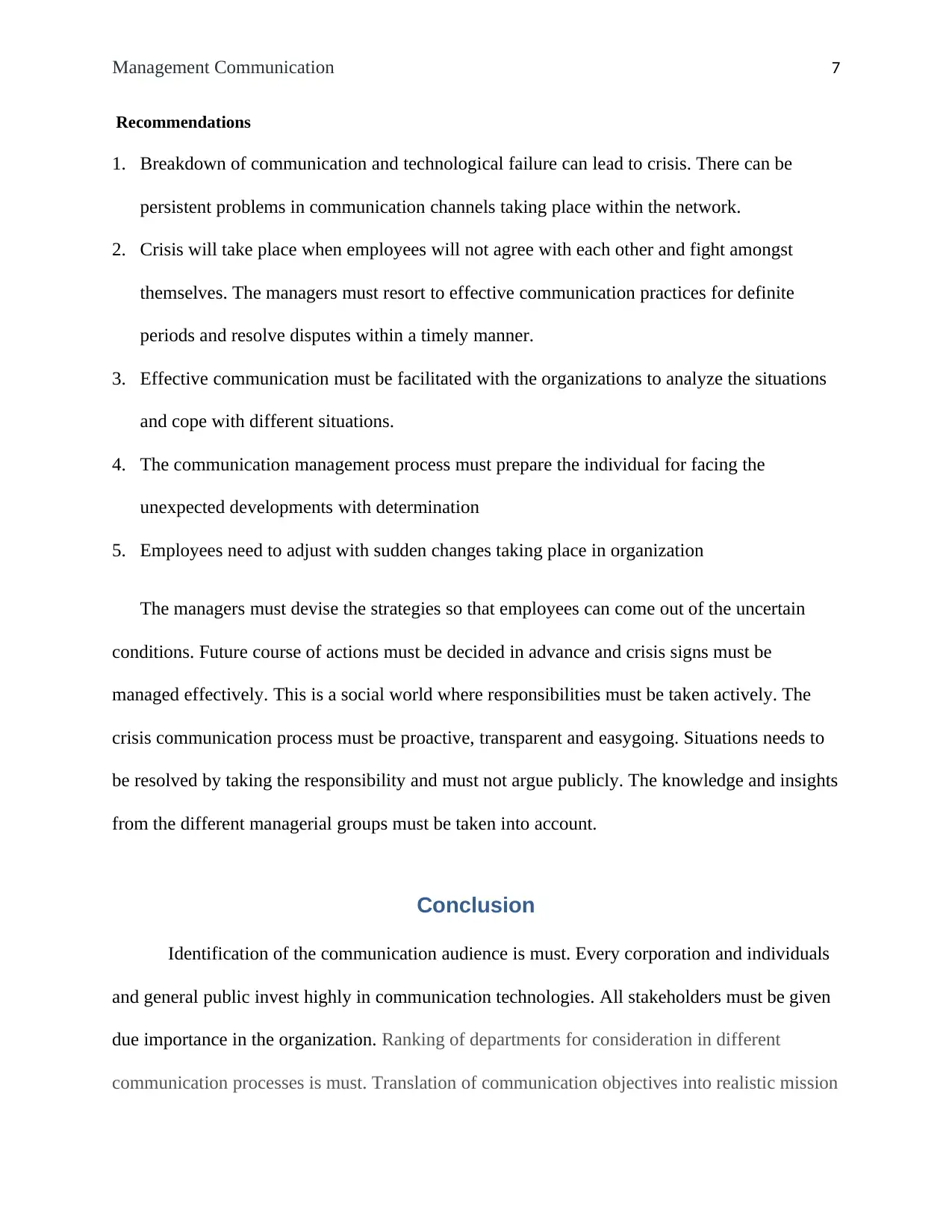
Management Communication 7
Recommendations
1. Breakdown of communication and technological failure can lead to crisis. There can be
persistent problems in communication channels taking place within the network.
2. Crisis will take place when employees will not agree with each other and fight amongst
themselves. The managers must resort to effective communication practices for definite
periods and resolve disputes within a timely manner.
3. Effective communication must be facilitated with the organizations to analyze the situations
and cope with different situations.
4. The communication management process must prepare the individual for facing the
unexpected developments with determination
5. Employees need to adjust with sudden changes taking place in organization
The managers must devise the strategies so that employees can come out of the uncertain
conditions. Future course of actions must be decided in advance and crisis signs must be
managed effectively. This is a social world where responsibilities must be taken actively. The
crisis communication process must be proactive, transparent and easygoing. Situations needs to
be resolved by taking the responsibility and must not argue publicly. The knowledge and insights
from the different managerial groups must be taken into account.
Conclusion
Identification of the communication audience is must. Every corporation and individuals
and general public invest highly in communication technologies. All stakeholders must be given
due importance in the organization. Ranking of departments for consideration in different
communication processes is must. Translation of communication objectives into realistic mission
Recommendations
1. Breakdown of communication and technological failure can lead to crisis. There can be
persistent problems in communication channels taking place within the network.
2. Crisis will take place when employees will not agree with each other and fight amongst
themselves. The managers must resort to effective communication practices for definite
periods and resolve disputes within a timely manner.
3. Effective communication must be facilitated with the organizations to analyze the situations
and cope with different situations.
4. The communication management process must prepare the individual for facing the
unexpected developments with determination
5. Employees need to adjust with sudden changes taking place in organization
The managers must devise the strategies so that employees can come out of the uncertain
conditions. Future course of actions must be decided in advance and crisis signs must be
managed effectively. This is a social world where responsibilities must be taken actively. The
crisis communication process must be proactive, transparent and easygoing. Situations needs to
be resolved by taking the responsibility and must not argue publicly. The knowledge and insights
from the different managerial groups must be taken into account.
Conclusion
Identification of the communication audience is must. Every corporation and individuals
and general public invest highly in communication technologies. All stakeholders must be given
due importance in the organization. Ranking of departments for consideration in different
communication processes is must. Translation of communication objectives into realistic mission
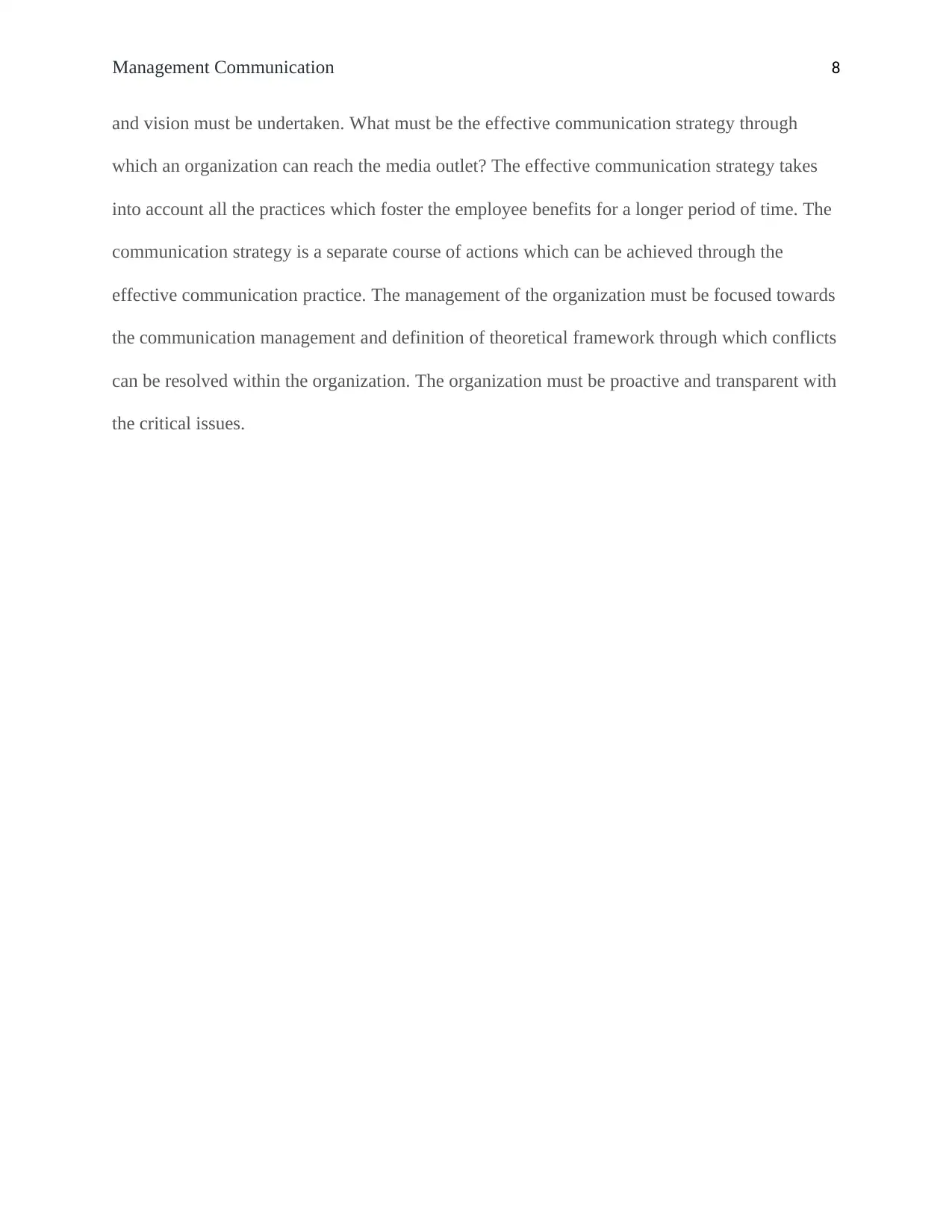
Management Communication 8
and vision must be undertaken. What must be the effective communication strategy through
which an organization can reach the media outlet? The effective communication strategy takes
into account all the practices which foster the employee benefits for a longer period of time. The
communication strategy is a separate course of actions which can be achieved through the
effective communication practice. The management of the organization must be focused towards
the communication management and definition of theoretical framework through which conflicts
can be resolved within the organization. The organization must be proactive and transparent with
the critical issues.
and vision must be undertaken. What must be the effective communication strategy through
which an organization can reach the media outlet? The effective communication strategy takes
into account all the practices which foster the employee benefits for a longer period of time. The
communication strategy is a separate course of actions which can be achieved through the
effective communication practice. The management of the organization must be focused towards
the communication management and definition of theoretical framework through which conflicts
can be resolved within the organization. The organization must be proactive and transparent with
the critical issues.
⊘ This is a preview!⊘
Do you want full access?
Subscribe today to unlock all pages.

Trusted by 1+ million students worldwide
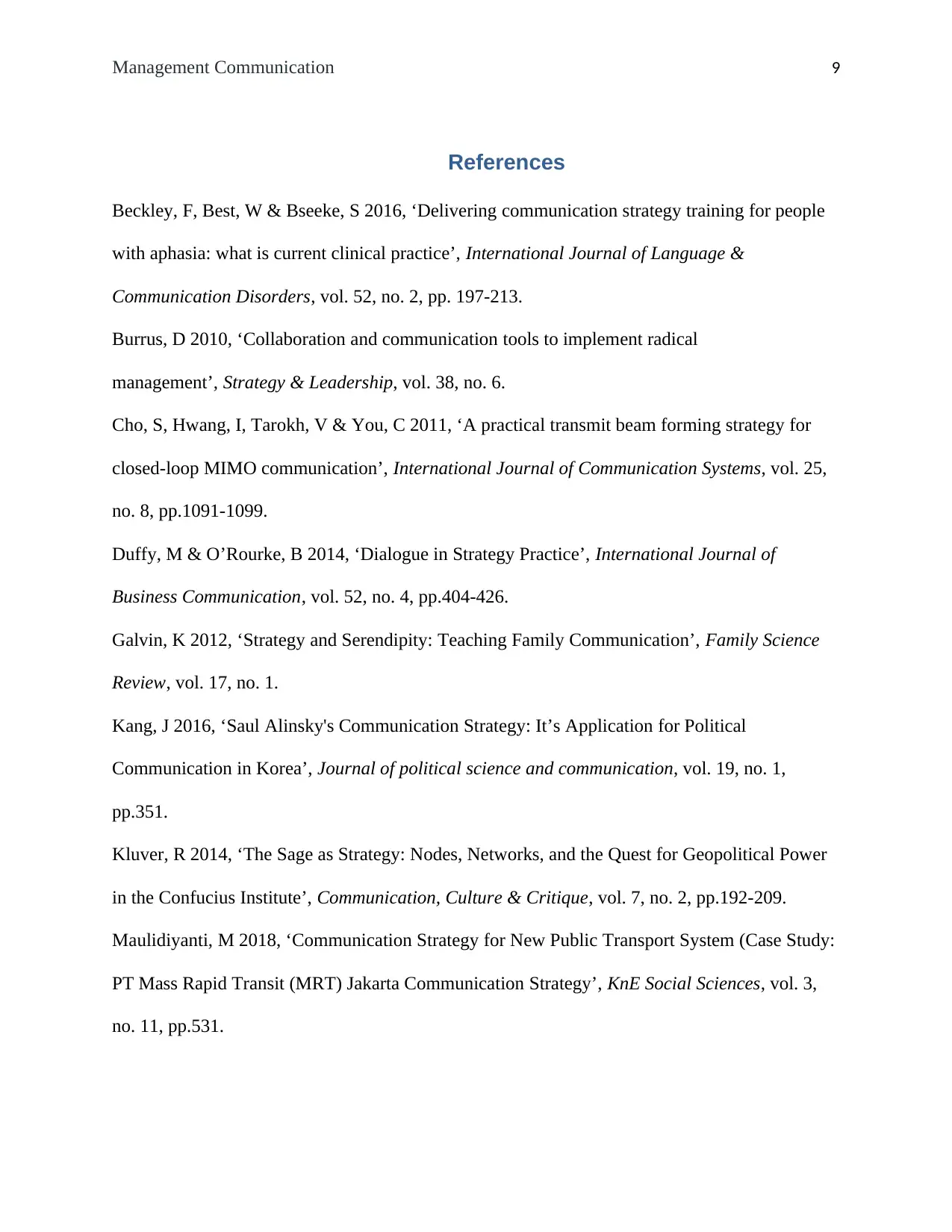
Management Communication 9
References
Beckley, F, Best, W & Bseeke, S 2016, ‘Delivering communication strategy training for people
with aphasia: what is current clinical practice’, International Journal of Language &
Communication Disorders, vol. 52, no. 2, pp. 197-213.
Burrus, D 2010, ‘Collaboration and communication tools to implement radical
management’, Strategy & Leadership, vol. 38, no. 6.
Cho, S, Hwang, I, Tarokh, V & You, C 2011, ‘A practical transmit beam forming strategy for
closed-loop MIMO communication’, International Journal of Communication Systems, vol. 25,
no. 8, pp.1091-1099.
Duffy, M & O’Rourke, B 2014, ‘Dialogue in Strategy Practice’, International Journal of
Business Communication, vol. 52, no. 4, pp.404-426.
Galvin, K 2012, ‘Strategy and Serendipity: Teaching Family Communication’, Family Science
Review, vol. 17, no. 1.
Kang, J 2016, ‘Saul Alinsky's Communication Strategy: It’s Application for Political
Communication in Korea’, Journal of political science and communication, vol. 19, no. 1,
pp.351.
Kluver, R 2014, ‘The Sage as Strategy: Nodes, Networks, and the Quest for Geopolitical Power
in the Confucius Institute’, Communication, Culture & Critique, vol. 7, no. 2, pp.192-209.
Maulidiyanti, M 2018, ‘Communication Strategy for New Public Transport System (Case Study:
PT Mass Rapid Transit (MRT) Jakarta Communication Strategy’, KnE Social Sciences, vol. 3,
no. 11, pp.531.
References
Beckley, F, Best, W & Bseeke, S 2016, ‘Delivering communication strategy training for people
with aphasia: what is current clinical practice’, International Journal of Language &
Communication Disorders, vol. 52, no. 2, pp. 197-213.
Burrus, D 2010, ‘Collaboration and communication tools to implement radical
management’, Strategy & Leadership, vol. 38, no. 6.
Cho, S, Hwang, I, Tarokh, V & You, C 2011, ‘A practical transmit beam forming strategy for
closed-loop MIMO communication’, International Journal of Communication Systems, vol. 25,
no. 8, pp.1091-1099.
Duffy, M & O’Rourke, B 2014, ‘Dialogue in Strategy Practice’, International Journal of
Business Communication, vol. 52, no. 4, pp.404-426.
Galvin, K 2012, ‘Strategy and Serendipity: Teaching Family Communication’, Family Science
Review, vol. 17, no. 1.
Kang, J 2016, ‘Saul Alinsky's Communication Strategy: It’s Application for Political
Communication in Korea’, Journal of political science and communication, vol. 19, no. 1,
pp.351.
Kluver, R 2014, ‘The Sage as Strategy: Nodes, Networks, and the Quest for Geopolitical Power
in the Confucius Institute’, Communication, Culture & Critique, vol. 7, no. 2, pp.192-209.
Maulidiyanti, M 2018, ‘Communication Strategy for New Public Transport System (Case Study:
PT Mass Rapid Transit (MRT) Jakarta Communication Strategy’, KnE Social Sciences, vol. 3,
no. 11, pp.531.
Paraphrase This Document
Need a fresh take? Get an instant paraphrase of this document with our AI Paraphraser
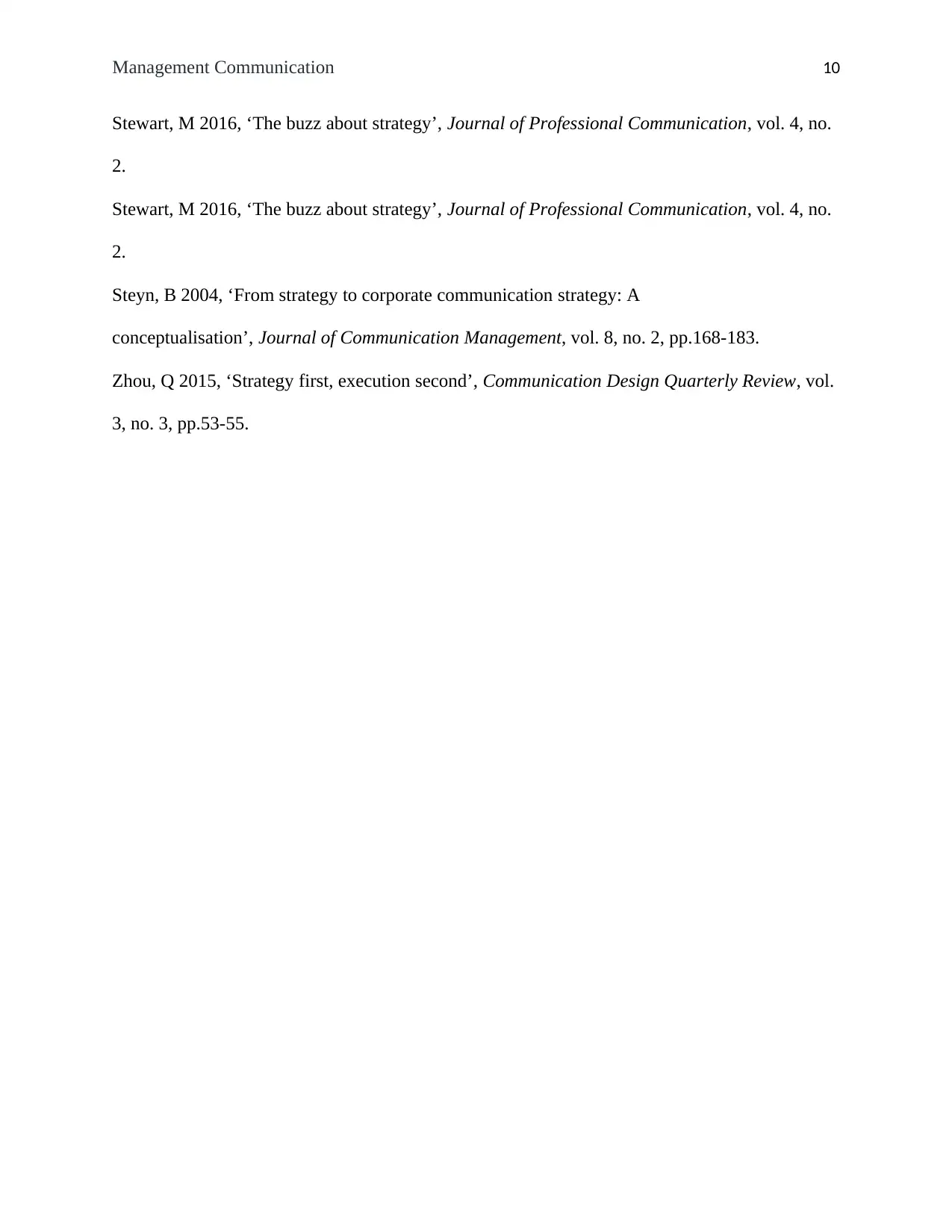
Management Communication 10
Stewart, M 2016, ‘The buzz about strategy’, Journal of Professional Communication, vol. 4, no.
2.
Stewart, M 2016, ‘The buzz about strategy’, Journal of Professional Communication, vol. 4, no.
2.
Steyn, B 2004, ‘From strategy to corporate communication strategy: A
conceptualisation’, Journal of Communication Management, vol. 8, no. 2, pp.168-183.
Zhou, Q 2015, ‘Strategy first, execution second’, Communication Design Quarterly Review, vol.
3, no. 3, pp.53-55.
Stewart, M 2016, ‘The buzz about strategy’, Journal of Professional Communication, vol. 4, no.
2.
Stewart, M 2016, ‘The buzz about strategy’, Journal of Professional Communication, vol. 4, no.
2.
Steyn, B 2004, ‘From strategy to corporate communication strategy: A
conceptualisation’, Journal of Communication Management, vol. 8, no. 2, pp.168-183.
Zhou, Q 2015, ‘Strategy first, execution second’, Communication Design Quarterly Review, vol.
3, no. 3, pp.53-55.
1 out of 11
Related Documents
Your All-in-One AI-Powered Toolkit for Academic Success.
+13062052269
info@desklib.com
Available 24*7 on WhatsApp / Email
![[object Object]](/_next/static/media/star-bottom.7253800d.svg)
Unlock your academic potential
Copyright © 2020–2025 A2Z Services. All Rights Reserved. Developed and managed by ZUCOL.



